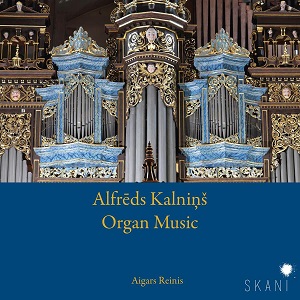
Alfrēds Kalniņš (1879-1951)
Organ Music
Aigars Reinis (organ)
rec. 2022, Riga Cathedral, Riga, Latvia
Skani LMIC149 [2 CDs: 117]
Although best remembered as the founder of the national Latvian opera and for his opera Baņuta (1920, review), Alfrēds Kalniņš was also the country’s most famous concert organist of his time, having studied the instrument with Louis Homilius at the St. Petersberg Conservatory between 1897 and 1901. His love of composition was also fired up during this period when he began composing songs. By 1951, the year of his death, he’d written 250 of them. From early on, however, the organ began to play a significant role, and he held a number of organist posts throughout his life. He spent the years 1927-1933 in the United States, and it was during his tenure as organist at Christ Church in New York that he met composer, organist and conductor Samuel Baldwin, who encouraged him to compose for the organ. Many of the works found in this collection post date his American sojourn.
The organ music spans a compositional period of almost fifty years between 1901 and 1949. It’s tonally pleasing, melodious, accessible and well crafted. The earliest piece is the Fantasia on track 1 of CD 1, which Kalniņš penned in 1901 when he was studying at the St. Petersberg Conservatory. It’s a very accomplished work for a young student still honing his skills. The composer, himself, considered it an improvisation, and it does sound very free-flowing and spontaneous. Pastorale No 1 of 1913 is lyrically attractive, with a ruddily bucolic complexion. Reinis conjures up a magical scene with some radiant, colourful registrations. Cloister Idyll explores some spectral harmonies, with everything kept under wraps. In total contrast is Procession, a melding of magisterial grandeur and architectural magnificence. Variations on a Theme by Jānis Kalniņš takes as its theme a hymn-like melody written by Alfrēds’ son, who was also a composer in his own right.
CD 2 opens with a piece from 1938 titled Agitato. Constant movement is enriched by uninhibited modulations and exciting rhythmic variations. Sabbath Eve, which follows, was written a year later. It couldn’t be more different, radiating a peaceful calm. There are two skilfully adapted transcriptions that Kalniņš made from his opera Baņuta. The virtuosic Prelude of 1941 demonstrates the composer’s consummate handling of rapid changes of harmony. A chorale “Jesus, my Son” was composed by Jāzeps Vītols (1863-1948), who was the most prominent Latvian composer of the first half of the 20th century. Kalniņš’ twelve variations on the theme reveal astonishing compositional flair and imagination. Reinis delivers a stunning performance in terms his commanding technique and ingenious registration choices, which add both colour and spice in abundance.
The four manual organ of Riga Cathedral, built by E. F. Walcker and Co. in 1884, underwent a restoration in 1984. It’s a fine-sounding instrument and regarded as one of the finest Romantic-style organs in Europe. The sound is superb, due to the adept skill of the engineers.
These delightful works are persuasively and authoritatively played, showcasing Aigars Reinis’ sensitive and subtle artistry. The booklet notes, in English and Latvian, are comprehensive, and provide all the necessary information. One minor irritation, though, is that some of the pages are printed in pale orange ink, which I found a strain on my eyes.
An attractive album which will appeal to any fan of organ music.
Stephen Greenbank
Help us financially by purchasing from


Contents
CD 1
Fantasia (1901)
Pastorale No 1 (1913)
Introduzione et Allegro (1928)
Cloister Idyll (1928)
Scherzo (1928)
Christmas Lullaby (1928)
Wedding March (1936)
Procession (1937)
Variations on a Theme by Janis Kalnins (1938)
CD 2
Agitato (1938)
Sabbath Eve (1939)
Stately Overture from the opera Banuta (transcription by the composer) (1920-1939)
Funeral March from the opera Banuta (transcription by the composer) (1920-1939)
Prelude (1941)
Pastorale No 2 (1943)
Variations on a Theme by Jazeps Vitols (1949)
A Hymn to My Native Land (1908-1911)


















